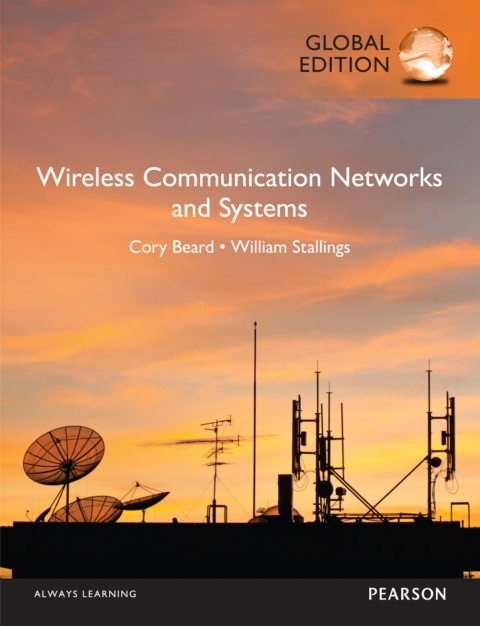Description
Efnisyfirlit
- Title Page
- Copyright Page
- Dedication
- Contents
- Preface
- Acknowledgments
- About the Authors
- Chapter 1 Introduction
- 1.1 Wireless Comes of Age
- 1.2 The Global Cellular Network
- 1.3 The Mobile Device Revolution
- 1.4 Future Trends
- 1.5 The Trouble With Wireless
- Part One Technical Background
- Chapter 2 Transmission Fundamentals
- 2.1 Signals for Conveying Information
- 2.2 Analog and Digital Data Transmission
- 2.3 Channel Capacity
- 2.4 Transmission Media
- 2.5 Multiplexing
- 2.6 Recommended Reading
- 2.7 Key Terms, Review Questions, and Problems
- Appendix 2A Decibels and Signal Strength
- Chapter 3 Communication Networks
- 3.1 Lans, Mans, and Wans
- 3.2 Switching Techniques
- 3.3 Circuit Switching
- 3.4 Packet Switching
- 3.5 Quality of Service
- 3.6 Recommended Reading
- 3.7 Key Terms, Review Questions, and Problems
- Chapter 4 Protocols and the TCP/IP Suite
- 4.1 The Need for a Protocol Architecture
- 4.2 The TCP/IP Protocol Architecture
- 4.3 The OSI Model
- 4.4 Internetworking
- 4.5 Recommended Reading
- 4.6 Key Terms, Review Questions, and Problems
- Appendix 4A Internet Protocol
- Appendix 4B Transmission Control Protocol
- Appendix 4C User Datagram Protocol
- Part Two Wireless Communication Technology
- Chapter 5 Overview of Wireless Communication
- 5.1 Spectrum Considerations
- 5.2 Line-Of-Sight Transmission
- 5.3 Fading in the Mobile Environment
- 5.4 Channel Correction Mechanisms
- 5.5 Digital Signal Encoding Techniques
- 5.6 Coding and Error Control
- 5.7 Orthogonal Frequency Division Multiplexing (OFDM)
- 5.8 Spread Spectrum
- 5.9 Recommended Reading
- 5.10 Key Terms, Review Questions, and Problems
- Chapter 6 The Wireless Channel
- 6.1 Antennas
- 6.2 Spectrum Considerations
- 6.3 Line-Of-Sight Transmission
- 6.4 Fading in the Mobile Environment
- 6.5 Channel Correction Mechanisms
- 6.6 Recommended Reading
- 6.7 Key Terms, Review Questions, and Problems
- Chapter 7 Signal Encoding Techniques
- 7.1 Signal Encoding Criteria
- 7.2 Digital Data, Analog Signals
- 7.3 Analog Data, Analog Signals
- 7.4 Analog Data, Digital Signals
- 7.5 Recommended Reading
- 7.6 Key Terms, Review Questions, and Problems
- Chapter 8 Orthogonal Frequency Division Multiplexing
- 8.1 Orthogonal Frequency Division Multiplexing
- 8.2 Orthogonal Frequency Division Multiple Access (OFDMA)
- 8.3 Single-Carrier FDMA
- 8.4 Recommended Reading
- 8.5 Key Terms, Review Questions, and Problems
- Chapter 9 Spread Spectrum
- 9.1 The Concept of Spread Spectrum
- 9.2 Frequency Hopping Spread Spectrum
- 9.3 Direct Sequence Spread Spectrum
- 9.4 Code Division Multiple Access
- 9.5 Recommended Reading
- 9.6 Key Terms, Review Questions, and Problems
- Chapter 10 Coding and Error Control
- 10.1 Error Detection
- 10.2 Block Error Correction Codes
- 10.3 Convolutional Codes
- 10.4 Automatic Repeat Request
- 10.5 Recommended Reading
- 10.6 Key Terms, Review Questions, and Problems
- Part Three Wireless Local and Personal Area Networks
- Chapter 11 Wireless LAN Technology
- 11.1 Overview and Motivation
- 11.2 IEEE 802 Architecture
- 11.3 IEEE 802.11 Architecture and Services
- 11.4 IEEE 802.11 Medium Access Control
- 11.5 IEEE 802.11 Physical Layer
- 11.6 Gigabit Wi-Fi
- 11.7 Other IEEE 802.11 Standards
- 11.8 IEEE 802.11I Wireless LAN Security
- 11.9 Recommended Reading
- 11.10 Key Terms, Review Questions, and Problems
- Appendix 11A Scrambling
- Chapter 12 Bluetooth and IEEE 802.15
- 12.1 The Internet of Things
- 12.2 Bluetooth Motivation and Overview
- 12.3 Bluetooth Specifications
- 12.4 Bluetooth High Speed and Bluetooth Smart
- 12.5 IEEE 802.15
- 12.6 ZigBee
- 12.7 Recommended Reading
- 12.8 Key Terms, Review Questions, and Problems
- Part Four Wireless Mobile Networks and Applications
- Chapter 13 Cellular Wireless Networks
- 13.1 Principles of Cellular Networks
- 13.2 First-Generation Analog
- 13.3 Second-Generation TDMA
- 13.4 Second-Generation CDMA
- 13.5 Third-Generation Systems
- 13.6 Recommended Reading
- 13.7 Key Terms, Review Questions, and Problems
- Chapter 14 Fourth Generation Systems and LTE-Advanced
- 14.1 Purpose, Motivation, and Approach to 4G
- 14.2 LTE Architecture
- 14.3 Evolved Packet Core
- 14.4 LTE Resource Management
- 14.5 LTE Channel Structure and Protocols
- 14.6 LTE Radio Access Network
- 14.7 LTE-Advanced
- 14.8 Recommended Reading
- 14.9 Key Terms, Review Questions, and Problems
- Chapter 15 Mobile Applications and Mobile IP
- 15.1 Mobile Application Platforms
- 15.2 Mobile App Development
- 15.3 Mobile Application Deployment
- 15.4 Mobile IP
- 15.5 Recommended Reading
- 15.6 Key Terms, Review Questions, and Problems
- Appendix 15A Internet Control Message Protocol
- Appendix 15B Message Authentication
- Chapter 16 Long Range Communications
- 16.1 Satellite Parameters and Configurations
- 16.2 Satellite Capacity Allocation
- 16.3 Satellite Applications
- 16.4 Fixed Broadband Wireless Access
- 16.5 WiMAX/IEEE 802.16
- 16.6 Smart Grid
- 16.7 Recommended Reading
- 16.8 Key Terms, Review Questions, and Problems
- References
- Index
- A
- B
- C
- D
- E
- F
- G
- H
- I
- JK
- L
- M
- N
- O
- P
- Q
- R
- S
- T
- U
- V
- W
- X
- YZ






Reviews
There are no reviews yet.